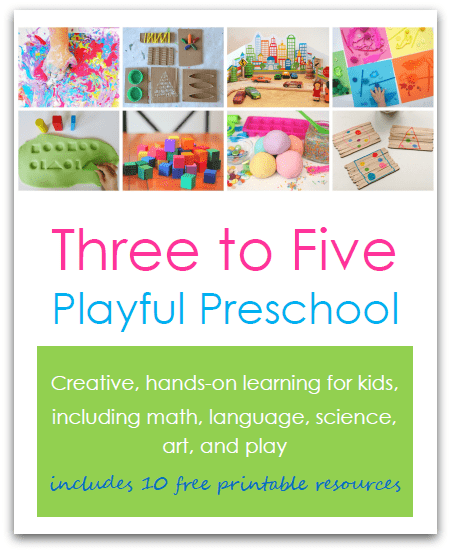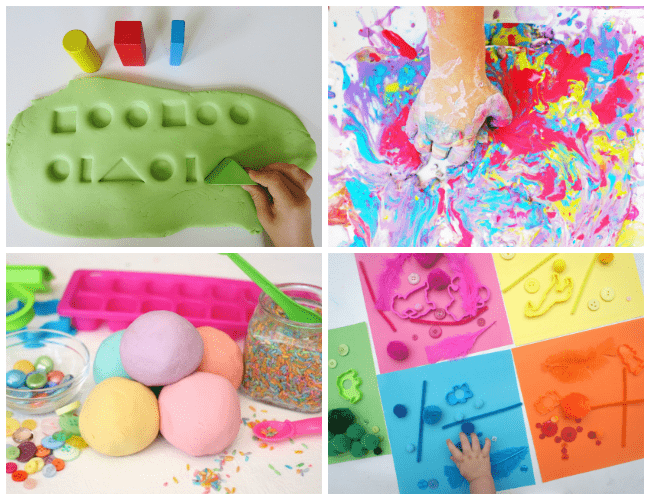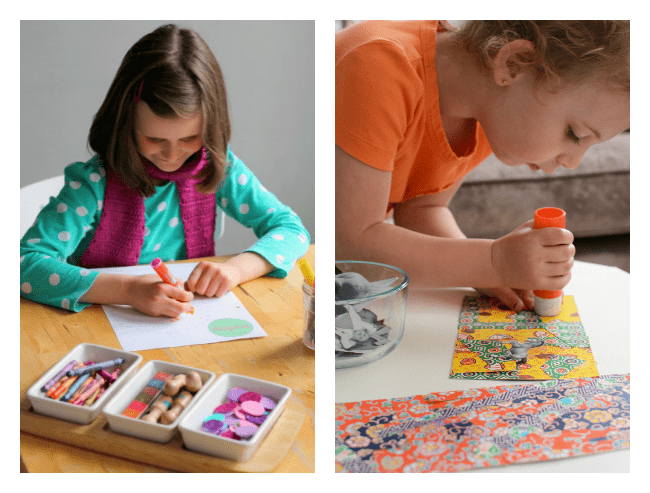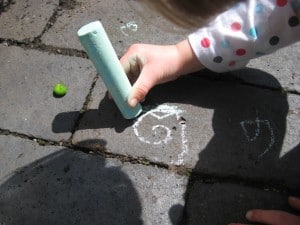Start your learning year with a back to school craft that inspires :: we’re painting our Words of the Year!
by Cathy James
Start your learning year with a back to school craft that inspires :: we’re painting our Words of the Year!
by Cathy James

Three to Five: playful preschool equips you with a wealth of easy activities that you can use to help your child learn through hands-on explorations.
It guides you through math, language, science, art, and play, showing you how to provide an engaging, age-appropriate curriculum that your children will love.
This ebook is an excellent resource for you whether you are at home, in a childcare setting, or in a preschool.
The ideas in the ebook are adaptable, with lots of suggestions for ways to extend the learning, and to include slightly younger or older children.
Get your copy for only $8.99 and you’re all set for a wonderful preschool year!

Three to Five: playful preschool will show you how to explore and learn across the curriculum, giving your child a rich and interesting learning environment, including:
:: math – with counting cards, sorting games, block tower printables, shape puzzles, and activities that explore size and patterns
:: language – with ideas for mark making, sensory letter activities, book explorations, conversation starters, sticker bag stories, and a ‘my first journal’ printable
:: sensory – with ideas including water play, play dough and oobleck
:: fine motor skills – including lacing, loose parts, and block play
:: imagination – with a fun play town printable
:: creativity – with invitations to explore collage, printmaking, and painting
:: science – with force experiments and a guide to nature discovery centers

You will also receive a fantastic set of printable resources including:
And as an added extra, the ebook includes links to over 50 more activities that focus on hands-on, playful learning for preschoolers – giving you a huge set of resources, all in one place.
by Cathy James
Starting School series: Learning to Write Your Own Name
We have been looking at ways we can help a child to get ready for starting school – you can view the starting school series here – and today our focus is on writing their own name. Learning to write their own name is quite a milestone for a child. It is important to understand that no-one will be expecting all children to start school already able to do this – some will be able to, many won’t. All skills are acquired as part of a learning journey. Here are some ideas you can use at home to help your child start to develop this skill.
 1. Let them see their name. Having their name around the house is a great first step in introducing the letters to your child. Every time they draw a picture, write their name on it. Always write their name correctly – with a first capital letter and the other letters in lowercase. Sure, at home they’re not in a class of other children so you don’t need to label their masterpiece to stop it getting mixed up with other children’s, but adding a name label demonstrates to them how to hold the pencil, how the letters go from left to right, how each character is formed. You can also add a name label above the peg where they hang their coat and make a nameplate to stick on their bedroom door. As they see their name popping up around the house they’ll be starting to memorise the shape and sequence of the letters.
1. Let them see their name. Having their name around the house is a great first step in introducing the letters to your child. Every time they draw a picture, write their name on it. Always write their name correctly – with a first capital letter and the other letters in lowercase. Sure, at home they’re not in a class of other children so you don’t need to label their masterpiece to stop it getting mixed up with other children’s, but adding a name label demonstrates to them how to hold the pencil, how the letters go from left to right, how each character is formed. You can also add a name label above the peg where they hang their coat and make a nameplate to stick on their bedroom door. As they see their name popping up around the house they’ll be starting to memorise the shape and sequence of the letters.
2. Make marks everywhere. Developing writing doesn’t have to be done with a pencil on a piece of paper. Young children benefit from making marks and starting to write letters on a large scale so begin by tracing letters in the air using broad arm movements. Make marks whenever you can, using fingers, sticks and paintbrushes, with sand, play dough and paint.
3. Provide a vertical writing surface such as a blackboard or paper on an easel. Writing on a vertical surface is a good way to naturally position the pencil and wrist in a writing position.
4. Give fingers a workout. You can develop dexterity and strengthen fingers which are soon going to be holding a pencil by playing with play dough or baking bread. This kind of play builds up finger strength and grip, ready for scribing.
5. Hunt out letters. Starting with your child’s initial you can go on a letter hunt – out and about in your neighbourhood like on our letter walk, or by searching through newspapers and magazines, as in this idea from No Time For Flashcards. Most importantly, remember to have fun with writing. Encourage children to feel proud about trying, without being overly concerned at this stage about perfectly formed letters.
All our favourite literacy activities, all in one place :: download our ABCs and 123s guide here.
by Cathy James
Welcome to part three in our series: Starting School.
In part one we looked at school dinners and part two considered putting on your own coat and shoes. This time we’re looking at a selection of great books which deal with the subject of starting school. Take your pick from the four books below – they’re all the perfect introduction to Big School. The books give you the chance to talk about the school day, the parts of the school your child will visit and the different people they will meet. Reading these a few times over the summer will give your child lots of opportunity to become familiar with the school routines, helping them to feel more ‘at home’ at big school.
by Cathy James
8.25am is the most stressful time of day in houses with school-age children*. That last push to get out of the door and off on the school run can be the biggest hurdle of the day. But it doesn’t have to be that way! Welcome to Part Two of our series: Starting School. In part one we looked at School Dinners, this time the topic is:
Putting on Your Own Coat and Shoes
A simple skill we grown-ups take for granted can actually be quite tricky for little ones to master. So here are a few thoughts which might help.
1. Let your child have a try. This sounds obvious but in the rush to get ready I see many parents doing up buttons and putting on shoes for their children. While this saves time, it’s not giving your child any chance to learn the skill for themself.
2. Take your time. You need to allow plenty of time to master this skill – so start when you’ve got lots of time to get ready, not when you’re already late. Little does a great job getting her own coat on, but the buttons take her ages. I have to remind myself to give her the time she needs – we wouldn’t rush along a child taking their first steps, so we need to slow down here too.
3. Give your child some Top Tips. You put on your shoes without even thinking about it, but does your child actually realise there’s a difference between their right and left foot and they need to match up the correct shoe with the correct foot? Little knows to line up her shoes on the floor before she puts them on. She knows that the flowers on the outside of each shoe shouldn’t be touching – if they are, she knows to swap them over. This is how she gets them on the correct feet. Even black school shoes often have a little pattern on the outside, so you should be able to get a pair with this picture clue. If not, maybe you can draw arrows or make a mark inside the shoe.
With coats our top tip is to get one with a hood. Then, the first step to putting it on is to put the hood on your head. This leaves both hands free to get the sleeves on – instead of having to hold the coat and get your arms in at the same time. Try it both ways and see how the Hood Manouvre helps!
4. Zips, button or toggles? Which can your child manage by themselves? Try a few in the shop and buy whichever your child finds easiest.
5. Laces or velcro? One child I know had a pair of high-top lace-up ankle boots, which were always tied (by their parent) in a double knot. She couldn’t even get the shoes off by herself, let alone lace them up. So my choice is always to go with a simple velcro strap.
With 25 children doing coats and shoes, up to 10 times in one day, your child’s new teacher will be so pleased you’ve worked on this!
(*Source: My good friend Catherine heard this on the radio. Not exactly scientific, but you agree don’t you?)
You might also like this idea for organising your school run.
Happily shared with WeareTHATfamily’s Works for me Wednesday
by Cathy James
Little is starting school in September. (See how calmly I typed that?) She is already excited about it and can’t wait to follow in Big’s footsteps. She currently attends the local pre-school each morning, where she has two best friends and lots of fun. She is confident and gregarious and I’m thinking she’ll find the transition to school OK, but I’ve been thinking about how I can help her get ready for her next step. I have no checklist of ‘Things Your Child Should Be Able To Do When They Start School’ in mind – that’s not how I think at all. But there are certain things it would be useful if she’d practised or skills she’d tried, before September rolls around.
Thinking ahead gives us plenty of time to play around with the idea of school. I thought I’d share some thoughts with you on a ‘Starting School’ theme as we go along – and hope you’ll offer some comments and ideas too. (And if you are homeschooling I hope you’ll still find some of the later topics relevant.)
Launching the Starting School topic is ‘School Dinners’.
Eating lunch somewhere unfamilar, helped by unfamilar adults can be a big deal. So how about some trial runs before the big day? We started off by going shopping for a special lunchbag and drinks bottle, chosen by Little herself. Then I let Little play with them – getting used to opening and closing them and having a pretend school lunch. This gives lots of opportunity to practice what might happen at school. We chatted about what she might like to eat and who she can ask to help her peel her banana. (Please note how many slices of cake she packed for herself.) If your child is going to be having dinners provided by the school they might benefit from practice at carrying a tray.
After Easter Little’s pre-school is running a Lunch Club one day a week, where the children can stay half an hour longer than usual had have lunch. This is a perfect first step, in a familar environment. If your own pre-school doesn’t offer a lunch club, maybe you could suggest one? Alternatively you could pair up with a friend and take turns hosting your own lunchclub at eachothers house.
Even if your child is used to having meals at a nursery this kind of roleplay is valuable. Get them used to the bag, bottles, containers they will be using at school. Can they open their own yoghurt pot? Unwrap the clingfilm on their sandwiches? You’d hate them to go hungry simply because they couldn’t get at their food.
So, those are my thoughts around school dinners. Do you have any other suggestions – I’d love you to leave a comment. And if there are any other topics you’d like me to cover, please let me know and I’ll do a post so we can swap ideas.

